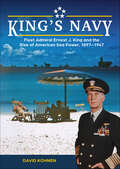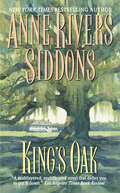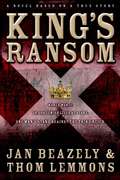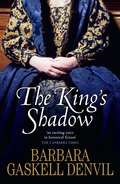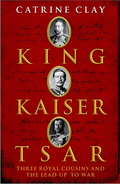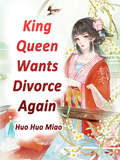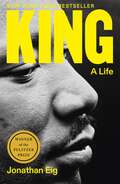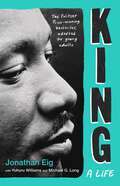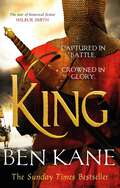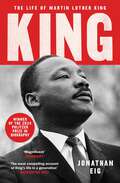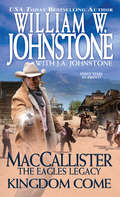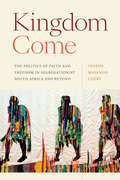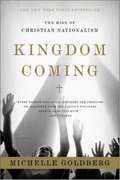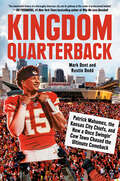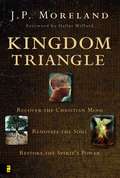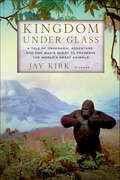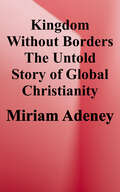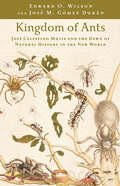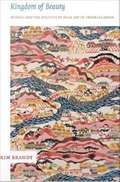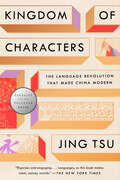- Table View
- List View
King's Navy: Fleet Admiral Ernest J. King and the Rise of American Sea Power, 1897–1947
by David KohnenAn authoritative account of the rise and fall of American sea power between 1897 and 1947 and the definitive biography of Fleet Admiral Ernest J. King. Between 1897 and 1945 the US Navy rose to lofty heights, with huge manpower, a lavish roster of ships, and a hard-earned reputation for professionalism and potency. By 1947, in the wake of the Second World War, the Navy, although still powerful, had been significantly scaled down; much of the senior leadership retired and the wartime edge gradually dulled. This period from 1897 to 1947 was witnessed and to a large degree driven and determined by two admirals, Ernest J. King and King's mentor William S. Sims. These admirals were empowered by two giants of American political and military history, Presidents Theodore Roosevelt and Franklin D. Roosevelt. Through the lives of King, Sims, and the Roosevelts, Naval War College historian David Kohnen has crafted a sweeping history of American sea power from 1897 to 1947. This epic work was made possible through 20 years of research and writing. By accessing undiscovered and recently declassified source material, along with the full cooperation of the King and Sims families, the author has been able to tell new stories and draw fresh conclusions, making this volume a must-have for scholars of naval history.
King's Oak
by Anne Rivers SiddonsHe would make her whole againLeaving behind a disastrous marriage, Andy Calhoun moves to the small town of Pemberton, Georgia, "in search of banality." What she discovers, though, is not serenity, but Tom Dabney, a passionate and magical man.An exuberant poet who worships the wilderness surrounding Pemberton, Tom is everything Andy doesn't need in her life right now. But despite warnings from friends, Andy is soon deeply immersed in Tom's life and his world . . . a world he will do anything to protect. When Tom declares war on the enemy poisoning his woods, it becomes clear that Andy must choose between her life with Tom and the one she left behind . . . if Pemberton society will take her back.
King's Ransom
by Jan Beazely Thom LemmonsThe Faith to Face Tyranny Faith to Face the Third Reich Two Stories of Undaunted Courage Set during the darkest days of World War II,King’s Ransomtells the heroic story of Tsar Boris III, King of Bulgaria, and his extraordinary efforts to save his country’s Jewish population from Hitler’s concentration camps. Aware of the price he might pay for his risks, Boris faced the Third Reich with courage and resolve, firm in his Christian convictions that would not permit him to abandon nearly 50,000 Jews. Boris, along with members of the Orthodox Church, Jewish religious leaders, and others, ultimately ensured that no Bulgarian Jews lost their lives to Hitler’s regime. Based on a True Story Historically accurate, Boris’s quest to save Bulgaria’s Jews is interwoven with the love story of Daria, the Jewish attendant to the Bulgarian royal family, and Dobri, a sergeant in the king’s guard. With courageous characters and passionate storytelling,King’s Ransomreveals how individuals acting on faith can change the course of history. From the Trade Paperback edition.
King's Shadow
by Barbara Gaskell DenvilAndrew Cobham is a man of unconventional behaviour, his home is unusually grand, and he answers no questions. But as he keeps his own secrets safe, so he works to uncover those of others.It is 1483 and King Edward IV wears England's crown, but no king rules unchallenged. Often it is those closest to him who are the unexpected danger. When the king dies suddenly without clear cause, then rumour replaces fact - and Andrew Cobham is already working behind the scenes.Tyballis, when orphaned young, was forced into marriage with her neighbour, a bully and a simpleton. When she escapes his abuse, she meets Andrew Cobham, and gradually an uneasy alliance forms. Their friendship will take them in unusual directions as Tyballis becomes embroiled in Andrew's work and the danger which surrounds him.Eventually it is a motley gathering of thieves, informers, prostitutes and children that joins the game, determined to help Andrew uncover treason. And as the country is brought to the brink of war, Andrew and Tyballis discover something neither thought was possible.A thrilling story of abduction, murder and subterfuge by one of Australia's finest historical writers.
King, Kaiser, Tsar
by Catrine ClayDuring the last days of July 1914 telegrams flew between the King, the Kaiser and the Tsar. George V, Wilhelm II and Nicholas II, known in the family as Georgie, Willy and Nicky, were cousins. Between them they ruled over half the world. They had been friends since childhood. But by July 1914 the Trade Union of Kings was falling apart. Each was blaming the other for the impending disaster of the First World War. 'Have I gone mad ' Nicky asked his wife Alix in St Petersburg, showing her another telegram from Willy. 'What on earth does William mean pretending that it still depends on me whether war is averted or not!' Behind the friendliness of family gatherings lurked family quarrels, which were often played out in public. Drawing widely on previously unpublished documents, this is the extraordinary story of their overlapping lives, conducted in palaces of unimaginable opulence, surrounded by flattery and political intrigue. And through it runs the question: to what extent were the King, the Kaiser and the Tsar responsible for the outbreak of the war, and, as it turned out, for the end of autocratic monarchy
King, Kaiser, Tsar: Three Royal Cousins Who Led The World To War
by Catrine ClayDuring the last days of July 1914 telegrams flew between the King, the Kaiser and the Tsar. George V, Wilhelm II and Nicholas II, known in the family as Georgie, Willy and Nicky, were cousins. Between them they ruled over half the world. They had been friends since childhood. But by July 1914 the Trade Union of Kings was falling apart. Each was blaming the other for the impending disaster of the First World War. 'Have I gone mad ' Nicky asked his wife Alix in St Petersburg, showing her another telegram from Willy. 'What on earth does William mean pretending that it still depends on me whether war is averted or not!' Behind the friendliness of family gatherings lurked family quarrels, which were often played out in public. Drawing widely on previously unpublished documents, this is the extraordinary story of their overlapping lives, conducted in palaces of unimaginable opulence, surrounded by flattery and political intrigue. And through it runs the question: to what extent were the King, the Kaiser and the Tsar responsible for the outbreak of the war, and, as it turned out, for the end of autocratic monarchy
King, Queen Wants Divorce Again!: Volume 1 (Volume 1 #1)
by Huo HuoMiaoShe was the daughter of a renowned imperial merchant, yet she had failed miserably in the hands of the scum man and the concubine girl. Not only was the whole family executed, they were even burned to death in the Sky Prison.When she had to live a new life, she had to make every step of the way. However, when she sought to ensure the safety of the Su Clan, she found a prince who openly desired to marry into the Dark Alliance.However, in this business, she was an expert. She would never lose anything. If she didn't want to be an idiot, then so be it.Unexpectedly, the business grew bigger and bigger, eventually becoming a queen.Su Zixuan: I want Li!Eunuch and palace maid: Empress, think twice!Su Zixuan: I don't care! I want to leave!Eunuch and palace maid: "Your Majesty!" The empress wants to leave again!Your Majesty: Let's go back to the sleeping quarters and have a talk.
King, Queen Wants Divorce Again!: Volume 2 (Volume 2 #2)
by Huo HuoMiaoShe was the daughter of a renowned imperial merchant, yet she had failed miserably in the hands of the scum man and the concubine girl. Not only was the whole family executed, they were even burned to death in the Sky Prison.When she had to live a new life, she had to make every step of the way. However, when she sought to ensure the safety of the Su Clan, she found a prince who openly desired to marry into the Dark Alliance.However, in this business, she was an expert. She would never lose anything. If she didn't want to be an idiot, then so be it.Unexpectedly, the business grew bigger and bigger, eventually becoming a queen.Su Zixuan: I want Li!Eunuch and palace maid: Empress, think twice!Su Zixuan: I don't care! I want to leave!Eunuch and palace maid: "Your Majesty!" The empress wants to leave again!Your Majesty: Let's go back to the sleeping quarters and have a talk.
King, Queen Wants Divorce Again!: Volume 3 (Volume 3 #3)
by Huo HuoMiaoShe was the daughter of a renowned imperial merchant, yet she had failed miserably in the hands of the scum man and the concubine girl. Not only was the whole family executed, they were even burned to death in the Sky Prison.When she had to live a new life, she had to make every step of the way. However, when she sought to ensure the safety of the Su Clan, she found a prince who openly desired to marry into the Dark Alliance.However, in this business, she was an expert. She would never lose anything. If she didn't want to be an idiot, then so be it.Unexpectedly, the business grew bigger and bigger, eventually becoming a queen.Su Zixuan: I want Li!Eunuch and palace maid: Empress, think twice!Su Zixuan: I don't care! I want to leave!Eunuch and palace maid: "Your Majesty!" The empress wants to leave again!Your Majesty: Let's go back to the sleeping quarters and have a talk.
King, Queen Wants Divorce Again!: Volume 4 (Volume 4 #4)
by Huo HuoMiaoShe was the daughter of a renowned imperial merchant, yet she had failed miserably in the hands of the scum man and the concubine girl. Not only was the whole family executed, they were even burned to death in the Sky Prison.When she had to live a new life, she had to make every step of the way. However, when she sought to ensure the safety of the Su Clan, she found a prince who openly desired to marry into the Dark Alliance.However, in this business, she was an expert. She would never lose anything. If she didn't want to be an idiot, then so be it.Unexpectedly, the business grew bigger and bigger, eventually becoming a queen.Su Zixuan: I want Li!Eunuch and palace maid: Empress, think twice!Su Zixuan: I don't care! I want to leave!Eunuch and palace maid: "Your Majesty!" The empress wants to leave again!Your Majesty: Let's go back to the sleeping quarters and have a talk.
King: A Life
by Jonathan EigWINNER OF THE 2024 PULITZER PRIZE FOR BIOGRAPHYA finalist for the 2023 National Book Critics Circle Award | Named one of the ten best books of 2023 by The Washington Post, Chicago Tribune, and TimeA New York Times bestseller and notable book of 2023 | One of Barack Obama’s favorite books of 2023One of The New Yorker’s essential reads of 2023 | A Christian Science Monitor best book of the year | One of Air Mail’s twelve best books of 2023A Washington Post and national indie bestseller | One of Publishers Weekly’s best nonfiction books of 2023 | One of Smithsonian magazine’s ten best books of 2023“Supple, penetrating, heartstring-pulling and compulsively readable . . . Eig’s book is worthy of its subject.” —Dwight Garner, The New York Times (Editors’ Choice)“[King is] infused with the narrative energy of a thriller . . . The most compelling account of King’s life in a generation.” —Mark Whitaker, The Washington Post“No book could be more timely than Jonathan Eig’s sweeping and majestic new King . . . Eig has created 2023′s most vital tome.” —Will Bunch, The Philadelphia InquirerHailed by The New York Times as “the new definitive biography,” King mixes revelatory new research with accessible storytelling to offer an MLK for our times.Vividly written and exhaustively researched, Jonathan Eig’s King: A Life is the first major biography in decades of the civil rights icon Martin Luther King Jr.—and the first to include recently declassified FBI files. In this revelatory new portrait of the preacher and activist who shook the world, the bestselling biographer gives us an intimate view of the courageous and often emotionally troubled human being who demanded peaceful protest for his movement but was rarely at peace with himself. He casts fresh light on the King family’s origins as well as MLK’s complex relationships with his wife, father, and fellow activists. King reveals a minister wrestling with his own human frailties and dark moods, a citizen hunted by his own government, and a man determined to fight for justice even if it proved to be a fight to the death. As he follows MLK from the classroom to the pulpit to the streets of Birmingham, Selma, and Memphis, Eig dramatically re-creates the journey of a man who recast American race relations and became our only modern-day founding father—as well as the nation’s most mourned martyr.In this landmark biography, Eig gives us an MLK for our times: a deep thinker, a brilliant strategist, and a committed radical who led one of history’s greatest movements, and whose demands for racial and economic justice remain as urgent today as they were in his lifetime.Includes 8 pages of black-and-white photographs
King: A Life (Young Adult Edition)
by Jonathan EigHailed as “the most compelling account of [Martin Luther] King’s life in a generation” by the Washington Post, the Pulitzer Prize–winning bestseller is now adapted for young adults in this new standard biography of the most famous civil rights activist in American History. Often regarded as more of a myth and legend than man, the Reverend Dr. Martin Luther King Jr. was many things throughout his storied life: student, activist, preacher, dreamer, father, husband. From his Atlanta childhood centered in the historically Black neighborhood of Sweet Auburn to his precipitous rise as a civil rights leader on the streets of Birmingham, Selma, and Montgomery, Dr. King would go on to become one of the most recognizable, influential, and controversial persons of the twentieth century.In this fast-paced and immersive adaptation of Jonathan Eig’s groundbreaking New York Times bestseller readers will meet a Dr. King like no other: a committed radical whose demands for racial and economic justice remain as urgent today as they were in his lifetime, a minister wrestling with his human frailties and dark moods, a citizen hunted by his own government.The inspiring young adult edition of King: A Life highlights the author’s never-before-seen research—including recently declassified FBI documents—while reaffirming and recontextualizing the lasting effects and implications of MLK’s work for the present day. Adapted by National Book Award–nominated authors Yohuru Williams and Michael G. Long, this biography for a new generation is a nuanced, unprecedented portrayal of a man who truly shook the world.Accolades and Praise for King: A Life: Pulitzer Prize WinnerA New York Times, Washington Post, and Indie BestsellerA National Book Award Nominee One of Barack Obama’s Favorite Books of the Year A National Book Critics Circle Award Finalist A “Best Book of the Year” from New York Times ● Washington Post ● TIME Magazine ● The New Yorker ● Publishers Weekly ● The Chicago Tribune ● Smithsonian Magazine ● Christian Science Monitor ● Air Mail“Supple, penetrating, heartstring-pulling and compulsively readable . . . Eig’s book is worthy of its subject.” —New York Times “No book could be more timely than Jonathan Eig’s sweeping and majestic new King.” —Philadelphia Inquirer
King: A rip-roaring epic adventure novel of one of history’s greatest warriors by the Sunday Times bestselling author
by Ben KaneThe thrilling adventure story about history's greatest warrior: Richard the Lionheart Autumn 1192. At the end of the Third Crusade Jerusalem remains in the Saracens' hands, and a peace treaty is agreed with their leader Saladin. Richard the Lionheart is finally free to travel to England and restore peace to his kingdom, under threat from his treacherous brother John. However, the epic journey will test every limit of his endurance as it takes him deeper into lands controlled by his enemies. He is ultimately captured near Vienna, imprisoned for three years, which further fans the flames of unrest in England and beyond. If he finally returns home, what will remain of his kingdom? And what deadly price must he pay to restore order?
King: A rip-roaring epic adventure novel of one of history’s greatest warriors by the Sunday Times bestselling author
by Ben KaneThe thrilling adventure story about history's greatest warrior: Richard the Lionheart Autumn 1192. At the end of the Third Crusade Jerusalem remains in the Saracens' hands, and a peace treaty is agreed with their leader Saladin. Richard the Lionheart is finally free to travel to England and restore peace to his kingdom, under threat from his treacherous brother John. However, the epic journey will test every limit of his endurance as it takes him deeper into lands controlled by his enemies. He is ultimately captured near Vienna, imprisoned for three years, which further fans the flames of unrest in England and beyond. If he finally returns home, what will remain of his kingdom? And what deadly price must he pay to restore order?
King: The Life of Martin Luther King
by Jonathan EigThe compelling story of Martin Luther King's life and achievements has become simplified and domesticated in a way that fails to do full justice to his radical vision and importance. Now, in King, we get the most comprehensive and complete portrait ever written about this iconic figure. The first major new biography of Martin Luther King Jr in over 40 years, Jonathan Eig's superb King is based on years of research, hundreds of interviews with those who knew him and many thousands of previously unreleased documents, including a huge cache from the FBI. Eig reveals King's story to be more compelling and more complex than we knew. For too long, his radical vision for the future has been erased. The hope of his 'I have a dream' message and the tragedy of his assassination at the age of 39 have overwhelmed the story of a brilliantly bold and complicated man, which obscures his real significance of today's society and for the future. His vision went far beyond achieving equal treatment for black men and women, which was only a part of a much greater and more wide-ranging mission - something that has been forgotten by most. Eig's fascinating biography not only shines new light on King's remarkable career, but also humanises him so that he becomes more than a symbol of hope and defiance, but a man with flaws, a sense of humour, as a father and a husband. It's an essential read for our times.
Kingdom Come (A Duff MacCallister Western #5)
by William W. Johnstone J.A. JohnstoneUSA Today-Bestselling Author:When a family member falls victim to a cutthroat gang in Texas, a Wyoming rancher hits the road ready for war…Standing for family, honor, and a way of life, the MacCallisters have carved out a hard-won corner of the Wyoming frontier. In the thrilling new novel from the bestselling Western writers, Duff MacCallister faces his most treacherous and deadly fight yet.Kingdom Come Like a murderous plague, a band of cutthroats and criminals, led by prison escapees from New Mexico, rages through West Texas. They're slaughtering everyone in their path: men, women and children. They struck at Saragosa. Now they've taken over the town of Boracho. The Dallas newspapers call them the Kingdom Come Gang. In Chugwater, Wyoming, Duff McCallister calls them his enemy. Because one of their victims was family.Now it's personal Riding to Texas, Duff gathers every man he can to make an assault on Boracho, even using a hardcase recruited from behind bars. Facing a brutal, merciless enemy, with innocent hostages caught in between, Duff is soon in a full blast war, with guns, knives, and dynamite exploding on dirt streets soaked in blood. And it won't be over until a hero makes a final stand.
Kingdom Come: The Politics of Faith and Freedom in Segregationist South Africa and Beyond (Religious Cultures of African and African Diaspora People)
by Tshepo Masango ChéryIn Kingdom Come, Tshepo Masango Chéry charts a new genealogy of early twentieth-century Black Christian activists who challenged racism in South Africa before the solidification of apartheid by using faith as a strategy against global racism. Masango Chéry traces this Black freedom struggle and the ways that South African church leaders defied colonial domination by creating, in solidarity with Black Christians worldwide, Black-controlled religious institutions that were geared toward their liberation. She demonstrates how Black Christians positioned the church as a site of political resistance and centered specifically African visions of freedom in their organizing. Drawing on archival research spanning South Africa, Zimbabwe, Kenya, the United Kingdom, and the United States, Masango Chéry tells a global story of the twentieth century that illuminates the formations of racial identity, state control, and religious belief. Masango Chéry’s recentering of South Africa in the history of worldwide Black liberation changes understandings of spiritual and intellectual routes of dissemination throughout the diaspora.
Kingdom Coming: The Rise of Christian Nationalism
by Michelle GoldbergMichelle Goldberg, a senior political reporter for Salon. com, has been covering the intersection of politics and ideology for years. Before the 2004 election, and during the ensuing months when many Americans were trying to understand how an administration marked by cronyism, disregard for the national budget, and poorly disguised self-interest had been reinstated, Goldberg traveled through the heartland of a country in the grips of a fevered religious radicalism: the America of our time. From the classroom to the mega-church to the federal court, she saw how the growing influence of dominionism-the doctrine that Christians have the right to rule nonbelievers-is threatening the foundations of democracy. In Kingdom Coming, Goldberg demonstrates how an increasingly bellicose fundamentalism is gaining traction throughout our national life, taking us on a tour of the parallel right-wing evangelical culture that is buoyed by Republican political patronage. Deep within the red zones of a divided America, we meet military retirees pledging to seize the nation in Christ's name, perfidious congressmen courting the confidence of neo-confederates and proponents of theocracy, and leaders of federally funded programs offering Jesus as the solution to the country's social problems. With her trenchant interviews and the telling testimonies of the people behind this movement, Goldberg gains access into the hearts and minds of citizens who are striving to remake the secular Republic bequeathed by our founders into a Christian nation run according to their interpretation of scripture. In her examination of the ever-widening divide between believers and nonbelievers, Goldberg illustrates the subversive effect of this conservative stranglehold nationwide. In an age when faith rather than reason is heralded and the values of the Enlightenment are threatened by a mystical nationalism claiming divine sanction, Kingdom Coming brings us face to face with the irrational forces that are remaking much of America.
Kingdom Quarterback: Patrick Mahomes, the Kansas City Chiefs, and How a Once Swingin' Cow Town Chased the Ultimate Comeback
by Mark Dent Rustin DoddFresh off of a gutsy, thrilling 2023 Super Bowl win for the Kansas City Chiefs, two inspiring stories that fit perfectly together—a biography of superstar quarterback, Patrick Mahomes, who brought the Chiefs to their first Super Bowl win in fifty years in 2020 as well as a second in 2023, along with the historical struggles and recent resurgence of the former &“Paris of the Plains,&” Kansas City. There is nobody like Patrick Mahomes. In three seasons, he has won a Super Bowl and competed in another, earned the titles of First Team All-Pro, NFL Offensive Player of the Year, and league MVP, and turned the Kansas City Chiefs from famed playoff failures into the most successful team in the NFL. With his unique and groundbreaking playing style, and winning personality both on and off the field, Mahomes has become a truly transcendent quarterback in a journey that mirrors and accentuates the rebirth of the once swingin&’ cow town of Kansas City, Missouri. Once an adventure-filled jazz epicenter and nightlife hub to rival New Orleans, Kansas City&’s wild edges and captivating neighborhoods were snuffed out in pursuit of a suburbanized dream that largely left out people of color. It&’s been a long road attempting to move past the scars of segregation and overcome the city&’s flyover reputation, but Kansas City is now poised to make a comeback, and no other person or team embodies that hope like Patrick Mahomes and the Kansas City Chiefs. Kansas City and Mahomes represent the story of the midwestern American city—how they grew, how they shaped the country, how the sport of football came to mean so much to them, how they failed, and how they are changing. Kansas City–area natives Mark Dent and Rustin Dodd have written for outlets such as The New York Times, The Kansas City Star, and Texas Monthly, bringing their deep connection to the city, football expertise, and polished writing skills to create a serious book about a very entertaining subject—the rebirth of a city, a team&’s triumph, and how Patrick Mahomes, and the team he led, were exactly what was needed to bring Kansas City back together again.
Kingdom Triangle
by J. P. MorelandWestern society is in crisis, the result of our culture's embrace of naturalism and postmodernism. At the same time, the biblical worldview has been pushed to the margins. Christians have been strongly influenced by these trends, with the result that the personal lives of Christians often reflect the surrounding culture more than the way of Christ, and the church's transforming influence on society has waned. In Kingdom Triangle, J. P. Moreland issues a call to recapture the drama and power of kingdom living. He examines and provides a penetrating critique of these worldviews and shows how they have ushered in the current societal crisis. He then lays out a strategy for the Christian community to regain the potency of kingdom life and influence in the world. Drawing insights from the early church, he outlines three essential ingredients of this revolution: ? Recovery of the Christian mind ? Renovation of Christian spirituality ? Restoration of the power of the Holy Spirit He believes that evangelical Christianity can mature and lead the surrounding society out of the meaningless morass it finds itself in with humility and vision.
Kingdom Under Glass: A Tale of Obsession, Adventure, and One Man's Quest to Preserve the World's Great Animals
by Jay KirkA sweeping historical narrative of the life of Carl Akeley, the famed explorer and taxidermist who changed the way Americans viewed the conservation of the natural worldDuring the golden age of safaris in the early twentieth century, one man set out to preserve Africa's great beasts. In this epic account of an extraordinary life lived during remarkable times, Jay Kirk follows the adventures of the brooding genius who revolutionized taxidermy and created the famed African Hall we visit today at New York's Museum of Natural History. The Gilded Age was drawing to a close, and with it came the realization that men may have hunted certain species into oblivion. Renowned taxidermist Carl Akeley joined the hunters rushing to Africa, where he risked death time and again as he stalked animals for his dioramas and hobnobbed with outsized personalities of the era such as Theodore Roosevelt and P. T. Barnum. In a tale of art, science, courage, and romance, Jay Kirk resurrects a legend and illuminates a fateful turning point when Americans had to decide whether to save nature, to destroy it, or to just stare at it under glass.
Kingdom Without Borders: The Untold Story of Global Christianity
by Miriam AdeneyThe twenty-first century has opened with a rapidly changing map of Christianity. While its influence is waning in some of its traditional Western strongholds, it is growing at a phenomenal pace in the global South. And yet this story has largely eluded the corporate news brokers of the West. Layered as it is with countless personal and corporate stories of remarkable faith and witness, it nevertheless lies ghostlike behind the newsprint and webpages of our print media, outside the camera's vision on the network evening news.Miriam Adeney has lived, traveled and ministered widely. She has walked with Christians in and from the far reaches of the globe. As she pulls back the veil on real Christians--their faith, their hardships, their triumphs and, yes, their failures--an inspiring and challenging story of a kingdom that knows no borders takes shape.This is a book that coaxes us out of our comfortable lives. It beckons us to expand our vision and experience of the possibilities and promise of a faith that continues to shape lives, communities and nations.
Kingdom of Ants: José Celestino Mutis and the Dawn of Natural History in the New World
by Edward O. Wilson José M. DuránOne of the earliest New World naturalists, José Celestino Mutis began his professional life as a physician in Spain and ended it as a scientist and natural philosopher in modern-day Colombia. Drawing on new translations of Mutis's nearly forgotten writings, this fascinating story of scientific adventure in eighteenth-century South America retrieves Mutis's contributions from obscurity.In 1760, the 28-year-old Mutis—newly appointed as the personal physician of the Viceroy of the New Kingdom of Granada—embarked on a 48-year exploration of the natural world of northern South America. His thirst for knowledge led Mutis to study the region's flora, become a professor of mathematics, construct the first astronomical observatory in the Western Hemisphere, and amass one of the largest scientific libraries in the world. He translated Newton's writings and penned essays about Copernicus; lectured extensively on astronomy, geography, and meteorology; and eventually became a priest. But, as two-time Pulitzer Prize–winner Edward O. Wilson and Spanish natural history scholar José M. Gómez Durán reveal in this enjoyable and illustrative account, one of Mutis's most magnificent accomplishments involved ants. Acting at the urging of Carl Linnaeus—the father of taxonomy—shortly after he arrived in the New Kingdom of Granada, Mutis began studying the ants that swarmed everywhere. Though he lacked any entomological training, Mutis built his own classification for the species he found and named at a time when New World entomology was largely nonexistent. His unorthodox catalog of army ants, leafcutters, and other six-legged creatures found along the banks of the Magdalena provided a starting point for future study.Wilson and Durán weave a compelling, fast-paced story of ants on the march and the eighteenth-century scientist who followed them. A unique glance into the early world of science exploration, Kingdom of Ants is a delight to read and filled with intriguing information.
Kingdom of Beauty: Mingei and the Politics of Folk Art in Imperial Japan
by Kim BrandtA Study of the Weatherhead East Asian Institute, Columbia University Kingdom of Beauty shows that the discovery of mingei (folk art) by Japanese intellectuals in the 1920s and 1930s was central to the complex process by which Japan became both a modern nation and an imperial world power. Kim Brandt's account of the mingei movement locates its origins in colonial Korea, where middle-class Japanese artists and collectors discovered that imperialism offered them special opportunities to amass art objects and gain social, cultural, and even political influence. Later, mingei enthusiasts worked with (and against) other groups--such as state officials, fascist ideologues, rival folk art organizations, local artisans, newspaper and magazine editors, and department store managers--to promote their own vision of beautiful prosperity for Japan, Asia, and indeed the world. In tracing the history of mingei activism, Brandt considers not only Yanagi Muneyoshi, Hamada Shōji, Kawai Kanjirō, and other well-known leaders of the folk art movement but also the often overlooked networks of provincial intellectuals, craftspeople, marketers, and shoppers who were just as important to its success. The result of their collective efforts, she makes clear, was the transformation of a once-obscure category of pre-industrial rural artifacts into an icon of modern national style.
Kingdom of Characters: The Language Revolution That Made China Modern
by Jing TsuWhat does it take to reinvent a language?After a meteoric rise, China today is one of the world&’s most powerful nations. Just a century ago, it was a crumbling empire with literacy reserved for the elite few, as the world underwent a massive technological transformation that threatened to leave them behind. In Kingdom of Characters, Jing Tsu argues that China&’s most daunting challenge was a linguistic one: the century-long fight to make the formidable Chinese language accessible to the modern world of global trade and digital technology.Kingdom of Characters follows the bold innovators who reinvented the Chinese language, among them an exiled reformer who risked a death sentence to advocate for Mandarin as a national language, a Chinese-Muslim poet who laid the groundwork for Chairman Mao's phonetic writing system, and a computer engineer who devised input codes for Chinese characters on the lid of a teacup from the floor of a jail cell. Without their advances, China might never have become the dominating force we know today.With larger-than-life characters and an unexpected perspective on the major events of China&’s tumultuous twentieth century, Tsu reveals how language is both a technology to be perfected and a subtle, yet potent, power to be exercised and expanded.
